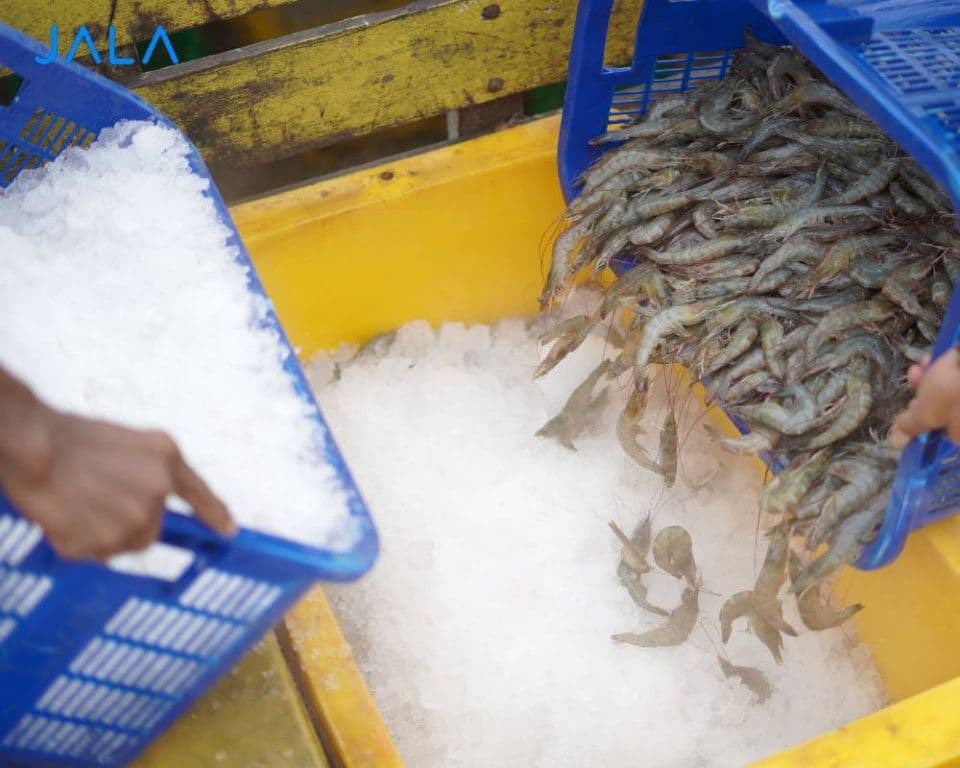
It is crucial to maintain the harvested shrimp’s quality during the distribution from the farm. This measure aims to preserve the nutritional content of shrimp, maintain the economic value of shrimp to remain optimal, and ensure higher profits for farmers.
The farmers and other stakeholders in the industry would suffer economic losses if the harvested shrimps are damaged or spoiled during distribution. Shrimps that are not fresh or damaged will be difficult to sell at high prices or even have to be thrown away. By maintaining quality during distribution, economic losses can be reduced.
Based on the explanation above, a good and proper method of distributing harvest must be implemented. One step that should not be skipped in the transportation process is storing shrimp with ice.
The functions of ice in the shrimp harvest distribution process
Since ice can preserve the shrimp's quality and freshness, its function is crucial in the distribution process. Once the shrimps have been put into the container and arranged carefully, a 1:1 ratio of bulk ice will be added. The layer-stack technique (ice-shrimp-ice-shrimp) is used in the setup.
After being harvested, shrimp must be handled properly to maintain their quality and freshness. Additionally, shrimp's nutritional quality can be maintained with the right usage of ice, ensuring that consumers still get the optimal nutritional benefits.
The following are five (5) functions of ice in the distribution process of shrimp harvest from the farm to the processing company.
- Shrimp freezing
Shrimp should be refrigerated immediately after harvest to slow spoilage. This is where the ice plays a role in keeping the shrimp fresh during distribution. Properly frozen shrimp will remain fresh and of high quality.
- Temperature control
Shrimp is an organism that is susceptible to temperature changes. Ice serves as an effective freezing medium to maintain optimal temperature during distribution. A stable and controlled temperature will help prevent bacterial growth, slow down the spoilage process, and maintain the quality of the shrimp.
- Preserving the texture of the shrimp
Shrimp texture will alter if they are exposed to overly hot or bad temperatures. In addition, bacteria that may cause disease grow more rapidly at warm temperatures. By using ice, shrimp temperature can be kept at an appropriate level to ensure that their texture is maintained.
- Prevent physical damage
During the process of shrimp distribution, the shaking and friction between shrimps can cause physical damage, such as broken tails or shell damage. The ice serves as a layer of protection and shock absorbers thereby reducing the risk of physical damage when the shrimp are distributed from the farm to the processing company.
- Increase storage life
Ice helps maintain the cold temperature needed to maintain the quality of the shrimp. By keeping the temperature low, ice helps slow down the spoilage process and extends the shrimp's storage life. This allows the distribution of shrimp over longer distances without compromising their quality.
The relatively simple use of ice makes it a practical and efficient option in the shrimp supply chain. Ice has a significant cooling capacity and is able to keep shipping containers at a low temperature. This ability is required to keep shrimp fresh and of high quality.
In addition, ice is safe to use in distributing food and easy to find. Many farms have easy access to ice because the infrastructure for ice storage and production is available. The cost of production and use of ice is also relatively low.
Source
Cooper, L. (2016). Safety tips for serving shrimp cocktail. Consumer Reports. https://www.consumerreports.org/food-safety/serve-a-safe-shrimp-cocktail-platter/
Lopez, G., Wang, M-J. (2003). Super chilling slurry ice quickly cools, preserves seafood. Global Seafood Alliance. https://www.globalseafood.org/advocate/super-chilling-slurry-ice-quickly-cools-preserves-seafood/
Tim Perikanan WWF Indonesia. (2014). Better Management Practices (BMP) Budidaya Udang Vannamei (Litopenaeus vannamei), Tambak Semi Intensif dengan Instalasi Pengolahan Air Limbah (IPAL). Jakarta; WWF Indonesia.





